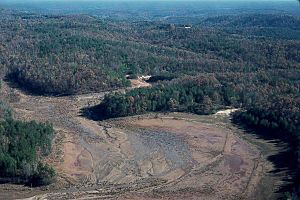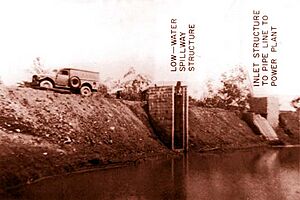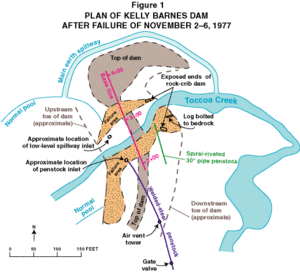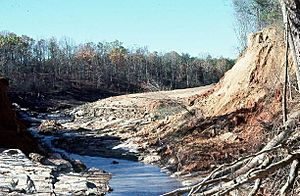Kelly Barnes Dam facts for kids
Quick facts for kids Kelly Barnes Dam |
|
|---|---|

View of former reservoir area after the dam failure.
|
|
| Location | Stephens County, Georgia, U.S. |
| Coordinates | 34°36′02″N 83°21′47″W / 34.60056°N 83.36306°W |
| Opening date | 1899 |
| Demolition date | November 6, 1977 |
| Dam and spillways | |
| Type of dam | Embankment dam |
| Height | 12 m (39 ft) |
| Length | 120 m (394 ft) |
| Width (crest) | 20 feet |
| Reservoir | |
| Creates | Barnes Lake |
| Total capacity | 505,730 m3 (17,860,000 cu ft) |
| Power station | |
| Commission date | 1899 |
| Installed capacity | 0.2 MW |
The Kelly Barnes Dam was a large dam made of earth and rocks in Stephens County, Georgia. It was located just outside the city of Toccoa. On November 6, 1977, after a lot of rain, the dam broke apart. The huge flood that followed sadly took the lives of 39 people and caused about $2.8 million in damage. The dam was never rebuilt after this disaster.
Today, a special memorial stands near Toccoa Falls on the campus of Toccoa Falls College. It helps everyone remember those who were lost in the flood.
Building the Dam: A Look Back
In 1899, a dam made of rocks and logs was first built by E. P. Simpson. Its purpose was to create a lake, or reservoir, for a small hydroelectric power plant. This plant started making electricity that same year. It was called the Old Toccoa Falls Power Plant and is now a historical site on the Toccoa Falls College campus. It used to make 200 kilowatts of power for the town of Toccoa.
In 1933, the power plant was given to the Toccoa Falls Institute. They wanted a more reliable way to get electricity. So, between 1939 and 1940, they built a new, stronger dam made of earth over the old rock and log dam. After World War II, the dam was made even taller. This created a bigger lake called Barnes Lake, which covered about 40 acres. These changes helped power the college until 1957. After that, the lake was just used for fun activities like swimming or boating.
How the Dam Was Built
The Kelly Barnes Dam was changed several times over the years. In its final form, it was about 38 feet (12 m) high and 400 feet (120 m) long. The top of the dam was 20 feet (6.1 m) wide.
The dam had two areas called spillways, which are like overflow channels for water. These spillways were not controlled, meaning they didn't have gates to open or close. The main spillway was about 380 feet (120 m) long and 11–60 feet (3.4–18.3 m) wide. It was on the left side of the dam. There was also a lower spot on the right side, away from the dam, that could act as a second spillway if the lake water got too high.
This dam, made of earth and rocks, was located about 2,000 feet (610 m) upstream from Toccoa Falls. It was mostly made of soil and silt. The dam sat on a strong base of silt and a type of rock called biotite gneiss.
Inside the dam, there were two structures made of stone. One of these structures helped hold up a pipe that was used as a low-level spillway. The other structure held a penstock, which is a pipe that carries water to power a hydroelectric plant. However, neither of these pipes was being used when the flood happened.
The Dam's Collapse in 1977
On November 6, 1977, at 1:30 in the morning, the Kelly Barnes Dam broke. This happened after four days of very heavy rain. About seven inches (180 mm) of rain had fallen between November 2 and 5. Half of that rain fell just between 6 pm and midnight on November 5. This huge amount of rain caused Barnes Lake to swell. Normally, the lake held about 17,859,600 cubic feet (505,730 m3) of water. But on that night, it was estimated to hold 27,442,800 cubic feet (777,090 m3) of water.
About 200 feet (61 m) of the dam broke apart. This sent a massive rush of water downstream, with a peak flow of about 24,000 cubic feet per second (680 m3/s).
The flood tragically killed 39 people. It also destroyed nine houses, 18 house trailers, two college buildings, and many cars and trucks. Five other houses and five college buildings were also damaged. Two bridges on Toccoa Falls Drive and a water tunnel at County Farm Road were completely washed away. The water pipe that supplied the city of Toccoa was damaged, and the city's water was unsafe to drink for several days. The total cost of all this damage was $2.8 million.
After the flood, Georgia's Governor George Busbee asked for an immediate investigation. A special team from the United States Geological Survey looked into what happened. Their report came out on December 21, 1977. They couldn't say for sure what caused the dam to fail. This was partly because there were no engineering plans for the dam. Records about its construction came from people who saw it being built, old pictures, and newspaper articles.
However, the investigation did point to several possible reasons for the failure. The way the dam's slope was built might have made it weak, especially with all the heavy rain. A collapse of the low-level spillway could have made this problem worse. A photo from 1973 showed that a 12-foot-high (3.7 m), 30-foot-wide (9.1 m) slide had happened on the back side of the dam. This might have been a sign that the dam was not strong enough. Overall, the dam was in poor condition and was not designed well enough to handle such conditions.






